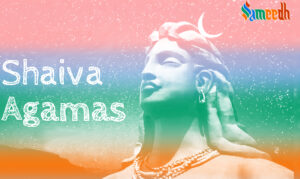The Raurava Agama specifically deals with the worship of Shiva in his form as Raurava, a fierce aspect representing destruction and regeneration. Like other Agama texts, it contains detailed instructions on temple construction, iconography, rituals, mantras, and meditation practices related to the worship of Shiv.

The Raurava Agama is a significant scripture within the Shaiva Agama tradition, focusing on the worship and rituals associated with Lord Shiv. It is one of the 28 Shaiva Agamas, which are a collection of texts that provide guidance on various aspects of temple construction, worship practices, rituals, and philosophical understanding within the Shaiva tradition.
The Raurava Agama, like many ancient Hindu scriptures, lacks precise historical documentation regarding its origins. However, it is considered to be one of the foundational texts within the Shaiva Agama tradition, which emerged and flourished during the early centuries of the Common Era.
The Shaiva Agama tradition comprises a vast corpus of texts that provide guidelines for temple construction, rituals, worship practices, philosophical understandings, and spiritual disciplines centered around Lord Shiv. These Agama texts were traditionally transmitted orally through lineages of priests and scholars and later committed to writing.
The exact time of the composition of the Raurava Agama is uncertain, but it likely emerged during a period of significant theological and philosophical development within Shaivism, which was influenced by various cultural, social, and religious factors prevailing in ancient India.
Over the centuries, the Raurava Agama, like other Agama texts, underwent revisions, additions, and commentaries by different scholars and practitioners. This process contributed to its evolution and adaptation to different regional and sectarian contexts within the broader Shaiva tradition.
The Raurava Agama gained prominence among Shaiva communities as a scripture devoted to the worship of Lord Shiv in his fierce aspect as Raurava, representing destruction and regeneration. It provided guidelines for conducting rituals, performing worship, constructing temples, and understanding the philosophical underpinnings of Shaivism.
While specific historical details about the composition and transmission of the Raurava Agama may be scarce, its continued relevance and influence within Shaiva communities testify to its enduring significance as a sacred scripture dedicated to the worship of Lord Shiv.
The Raurava Agama holds significant importance within the Shaiva Agama tradition and for devotees of Lord Shiva for several reasons:
- Guidance for Worship and Rituals: The Raurava Agama provides detailed instructions on the construction of Shiv temples, as well as the performance of various rituals, ceremonies, and worship practices dedicated to Lord Shiva in his form as Raurava. It serves as a comprehensive guide for priests and practitioners in conducting proper worship according to Shaiva traditions.
- Philosophical Understanding: Like other Agama texts, the Raurava Agama contributes to the philosophical understanding of Shaivism. It explores concepts related to the nature of reality, the role of Shiv as the supreme deity, and the cycle of creation, preservation, and destruction. Through its teachings, it helps devotees deepen their comprehension of Shaiva theology and philosophy.
- Spiritual Growth and Transformation: Devotees turn to the Raurava Agama for spiritual guidance and practices aimed at personal growth and transformation. The rituals, mantras, and meditation techniques prescribed in the scripture are believed to help practitioners cultivate devotion, purify the mind, and attain spiritual realization.
- Connection with Lord Shiv as Raurava: The Raurava Agama focuses specifically on the worship of Lord Shiv in his fierce aspect as Raurava, representing destruction and regeneration. By engaging in the practices outlined in the scripture, devotees seek to connect with this aspect of Shiv and invoke his blessings for protection, transformation, and liberation.
- Cultural and Religious Heritage: The Raurava Agama, along with other Shaiva Agama texts, contributes to the rich cultural and religious heritage of Hinduism. It preserves ancient rituals, traditions, and spiritual teachings that have been passed down through generations within Shaiva communities, helping to uphold and preserve the Shaiva tradition.
Overall, the Raurava Agama plays a vital role in guiding Shaiva practitioners in their worship, spiritual practice, and philosophical inquiry, while also serving as a repository of sacred knowledge and tradition within the broader Hindu religious landscape.